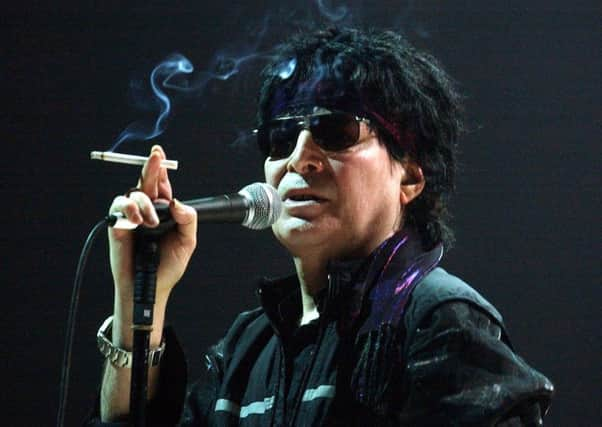Obituary: Alan Vega, iconic punk and electronic musician


Alan Vega was an American musician and visual artist who deserves to be remembered as one of the great musical innovators of the late 20th century. Although Suicide – the musical duo which he founded with Martin Rev in 1970 – were a strictly underground concern in the eyes of wider music fandom, their influence upon the spheres of punk, post-punk, industrial and electronic music spread through their contemporaries and on into much of what followed.
They were a band for connoisseurs, fellow musicians and those who expected to drop the needle on a record or step into a venue and have their preconceptions thoroughly challenged. “Alan Vega was one of the great revolutionary voices in rock and roll,” wrote Bruce Springsteen, who covered Suicide’s defining song Dream Baby Dream, when news of Vega’s passing broke. “The bravery and passion he showed throughout his career was deeply influential to me.”
Advertisement
Hide AdAdvertisement
Hide AdHardcore punk icon turned social and political commentator Henry Rollins said of Suicide’s eponymous 1977 debut album, and in particular the song Frankie Teardrop: “Nothing in your record collection or your life – outside of war – prepares you for the storyline. To this day, no record I own compares to that first Suicide album, and that song in particular. It remains the most intense thing I ever heard.”
The punishing track tells of a poverty-stricken young factory worker who murders his family and descends into hell; it also inspired Springsteen’s 1984 album Nebraska.
As Vega had it, Suicide were the first group to coin the term “punk” to refer to the style of music they made, advertising one early gig as a “Punk Music Mass” on the flyers (Vega says he took the term from a review by the seminal American rock critic Lester Bangs).
Their gigs were furious, primal affairs, eschewing the traditional rock band line-up in favour of a pulsing, blood-boiling synthesiser beat, minimal electric rock accompaniment from Rev, and Vega’s serrated, angry, provocative holler. The singer would often exacerbate the atmosphere by whipping at his audience with a length of bicycle chain, emulating his favourite comic book character, Marvel’s Ghost Rider; the band were named after a Ghost Rider strip entitled “Satan Suicide”, and one of their tracks bore the character’s name.
Riots were a regular feature of the Suicide live experience (as on the notorious live album 23 Minutes Over Brussels, the recording of an Elvis Costello support slot in Belgium), further emphasising any claims that they were the true, unvarnished sound of mean and lawless New York in the 1970s.
Touring the UK as support to the Clash in 1978, Vega would later maintain that the band had an axe thrown at them while onstage in Glasgow. “Nobody ever believed that story for years,” the singer told music website Pitchfork’s Simon Reynolds, “and then I did this solo gig in Leeds in 1987 and Jesus and Mary Chain came backstage afterwards and said they were there at the gig and they saw the axe flying by my head.” Known for their own minimal and furiously riotous gigs, of course, Glasgow’s Jesus and Mary Chain were just one band who owed a large debt to Suicide.
Alan Vega was born Boruch Alan Bermowitz in Brooklyn, New York, and raised the son of a diamond-setter father in the district of Bensonhurst. He escaped the then-residential borough at the age of 17, moving to Manhattan to study physics and fine art at Brooklyn College, and immersed himself in the city’s burgeoning 1960s art scene.
Something of a late bloomer in a musical sense, Vega was already into his thirties when Suicide emerged in 1970. Throughout his entire career the perception persisted that he was a decade younger than his actual age, the truth only emerging when a Suicide box set and tribute EP series was released to mark his 70th birthday in 2008.
Advertisement
Hide AdAdvertisement
Hide AdIn the late 1960s, Vega joined a group called the Project of Living Artists, who barricaded the Museum of Modern Art as a stunt to force payment for artists and devised their own 24-hour live-in gallery, called MUSEUM.
In 1969, his eyes were opened to the raw power of music as confrontational theatrical force when he saw Iggy Pop and the Stooges play, and shortly after he met Rev, a follow Jewish New Yorker with whom he maintained a solid lifelong friendship, despite their on-off musical partnership. Suicide played their first show (as a full band, although the other members soon fell away) at the Project of Living Artists in 1970.
The 1977 debut album made Suicide a cause célèbre among critics and musicians, although it made no impression on the overground. As well as Costello and the Clash, Blondie and the Ramones also invited them to play support slots, while groups as diverse as Joy Division, Pet Shop Boys, Nick Cave, Radiohead and the Chemical Brothers have all claimed Suicide as an influence.
Where the release of Suicide had been boundary-breaking, relative familiarity saw the band settle into a more esoteric – but still challenging – art-rock bracket throughout the rest of their career.
The second album Suicide: Alan Vega & Martin Rev arrived in 1980, and the duo technically split that year, with Vega’s self-titled debut solo album beginning a career under his own name which brought 18 rockabilly-style records and artistic collaborations over three decades.
Yet Vega and Rev’s association endured throughout their lives. As Suicide they also released A Way of Life (1988), Why Be Blue (1992) and American Supreme (2002), while Vega staged art exhibitions including Collision Drive (New York, 2002) and Infinite Mercy (France, 2009).
He suffered a stroke in 2012, but recovered and returned to work, before dying in his sleep in 2016. He is survived by his wife and collaborator, Liz Lamere, and their son, Dante.